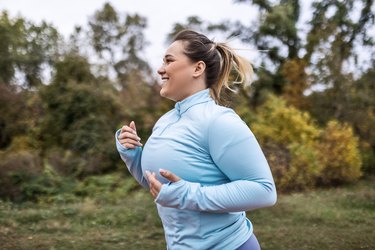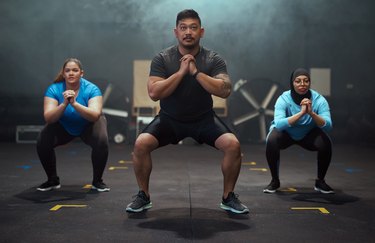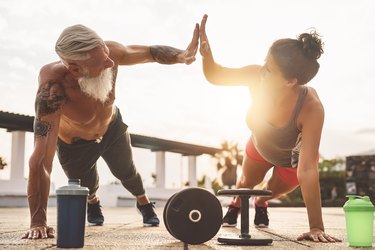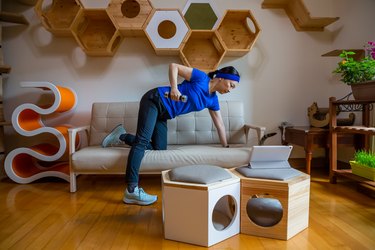
You may think the more calories you burn during a workout the better, but the quality of your workouts is really what counts toward your fitness and health goals.
In fact, an emphasis on calorie burn as a measure of the effectiveness of your workout is actually quite shortsighted and may undermine your goals. That's because a desire to consistently burn the most calories possible, to meet and even surpass the average calories burned in a workout, may prevent you from focusing on other worthy fitness goals.
Video of the Day
Video of the Day
"Focusing only on calorie burn is a great way to end up hating your workouts, and to find yourself missing out on some unique benefits that training has to offer, like building muscle mass and endurance," Vince Sant, CPT, a personal trainer and co-founder of V Shred, tells LIVESTRONG.com.
Plus, the pressure to reach a certain number of calories burned can lead to decreased satisfaction during and after finishing workouts, and might even lead you to give up your training all together. And of course, that'd be a major bummer, especially because there are so many great goals and benefits of exercise to focus on apart from that number, Sant says.
So, what's a realistic number of calories to expect to burn during a workout? That depends.
"There's no clear answer as to how many calories you should burn in a workout, as calorie burn depends on the workout and the individual, in relation to factors like body weight, metabolism, sex [assigned at birth], energy output and effort, activity level and more, which all affect the total calorie burn," says strength and conditioning coach and personal trainer John Shackleton, CSCS.
Here's what you need to know about burning calories and how to do it safely and productively — and in a way that doesn't make you feel bad and come to dread your workouts — if that's one of your goals.
Average Calories Burned in a Workout
To help contextualize how many calories you might burn during a given workout, take a look at how many calories the average person person burns during a 30-minute workout, based solely on their weight and exercise choice, according to Harvard Health Publishing.
The charts below will help you get a sense of average calories burned in a workout per activity, and you'll see how much that number can vary. Then keep reading for all the reasons why these numbers vary so much.
Walking (17 min/mile)
Weight (lbs) | 125 | 155 | 185 | 215 | 245 |
|---|---|---|---|---|---|
Calories Burned | 107 | 133 | 159 | 184 | 209 |
Running (12 min/mile)
Weight (lbs) | 125 | 155 | 185 | 215 | 245 |
|---|---|---|---|---|---|
Calories Burned | 240 | 288 | 336 | 390 | 444 |
Elliptical
Weight (lbs) | 125 | 155 | 185 | 215 | 245 |
|---|---|---|---|---|---|
Calories Burned | 270 | 324 | 378 | 439 | 500 |
Strength Training
Weight (lbs) | 125 | 155 | 185 | 215 | 245 |
|---|---|---|---|---|---|
Calories Burned | 90 | 108 | 126 | 146 | 166 |
Swimming
Weight (lbs) | 125 | 155 | 185 | 215 | 245 |
|---|---|---|---|---|---|
Calories Burned | 180 | 216 | 252 | 292 | 332 |
Why Calorie Burn Varies So Much
Exercise statistics show how many calories you should burn in a workout depends on numerous factors, including your body size, muscle mass, age and fitness or experience level. What constitutes a good calorie burn for you isn't necessarily what constitutes a good calorie burn for everyone else. Here are four factors that influence how many calories you burn during a workout.
1. Body Size
"The heavier you are the more calories you actually burn," as you need more fuel to power your body, Shackleton says.
For example, a 125-pound person walking for 30 minutes at a brisk 4 miles per hour burns 137 calories in 30 minutes, while their 185-pound friend burns 200 calories in that same amount of time, according to Harvard Health Publishing.
If your friend is heavier than you, they may burn more calories doing the same workout — but that doesn't make their session "better" than yours.
So don't let a comparison in final numerical results mislead you into thinking you didn't do a good job. This kind of negative self-talk and mentality can cause defeatism and interfere with progress.
Plus, people assigned male at birth (AMAB) typically burn more calories than people assigned female at birth (AFAB). "Again, this comes down to muscle mass," Shackleton says. Generally speaking, people AMAB tend to have larger bodies and more muscle mass. Remember, the larger you are, the greater your calorie burn will be.
2. Muscle Mass
Speaking of muscle: Another factor you might overlook when considering how best to burn calories and how much that number really matters: "Resistance training, which helps you build more muscle, typically burns fewer calories than cardio does when it comes to the actual workout, but having more muscle also helps you burn more calories in the day," Shackleton says.
"Muscle requires more energy to maintain than fat, even when the body is at rest throughout the day," he says. So if your goal is to increase calorie burn, you'll want to dedicate time to strength training and building muscle — not just cardio.
3. Age
Also, the older you are, the fewer calories you burn. "This is due to the fact that your hormones change and it becomes harder to maintain muscle, therefore causing calorie burn to slow down," Shackleton says.
4. Experience
Finally, there's the fact that you burn more calories working out at higher intensities, and beginner exercisers aren't as trained to hit such high speeds and heavy weights as more advanced exercisers. That's OK and totally normal.
Going too hard, too soon, in an attempt to burn a larger number of calories, can lead to burnout and injury. Not worth it, and extremely counterproductive if you end up having to take time off because of it.
How to Burn More Calories Safely
If your goal is to burn more calories — some people like to aim for a 200- to 250-calorie workout, for example — follow these tips to increase your intensity and activity without risking injury or burnout.
1. Strength Train
Build lean muscle to increase the number of calories you burn around the clock.
For the greatest benefits, choose large compound exercises like deadlifts, squats, bench presses and bent-over rows. These exercises recruit a wide array of muscle fibers to both increase calorie expenditure during your workout and to build the most metabolically active muscle.
2. Try Supersets
A superset is when you do two movements back to back, with little or minimal rest in between. Traditionally, that means exercises that target opposing muscle groups, like a chest press paired with a bent-over row.
"A lot of people like to stand around in between weight-training sessions, but if you are trying to burn more calories, supersets can be considered a form of high-intensity interval training [HIIT] as it involves moving from one strength-training exercise directly into another with little rest time in between," Shackleton says.
3. Do HIIT
Speaking of HIIT, high-intensity cardio can help you burn more calories, thanks to a phenomenon called excess post-exercise oxygen consumption, or EPOC. Basically, when your body has to work hard to return to its resting state after vigorous exercise, you'll burn a handful of extra calories.
"EPOC, which is sometimes referred to as the afterburn effect, refers to how much oxygen your body needs after a workout to bring your body back to homeostasis, which represents your normal resting metabolic state," Shackleton says. "And heavy lifting workouts and HIIT have been shown to increase your EPOC, allowing for more calorie burn."
4. Use Your Warm-Up Wisely
Those few minutes for a warmup can be the most you make of them, so use them wisely to burn off more calories right from the start.
Shackleton suggests warming up "pretty intensely, to really get your heart pumping." Try a 5-minute routine with arm circles, jumping jacks and air squats or 10 minutes on a stationary bike or rowing machine, he says.
5. Move More Throughout the Day
Staying active in addition to your regular workouts means more little bits of calorie-burning power here and there.
"There are still plenty of low-impact movements such as walking, doing chores, cleaning, etc., that are going to burn more calories than sitting around on your couch, so make sure to get up and keep moving and stretching throughout the day," Shackleton advises.
How to Track Calories Burned
Cardio machines, activity trackers, heart rate monitors, fitness apps and other tools can all provide you with an estimate of how many calories you burned in your workout, but they aren't going to be 100 percent accurate.
"The calorie calculators in cardio machines are built to reflect an average calorie burn for the average human body, and that may not look much like you," Sant says. "At best, it's inaccurate, but at worst, it's seriously misleading."
That doesn't mean they're totally useless. They can help you see trends over time. So, if you use the same tracker for every lifting session, you might notice that one type of workout burns 20 percent more calories than another. That can give you an idea of what will help you burn more. But the specific number of calories burned is not going to be spot on — another reason to not focus too hard on the exact number and more on the overall quality of your workout.
Other Exercise Benefits to Focus on Besides Calories
A healthy relationship with exercise looks like valuing activity for more than just calorie burn. For example, you appreciate the release of feel-good chemicals that improve your mood. You notice daily activities are easier because you are active. You protect yourself from injury and get better sleep. Staying active is an all-around health-booster, no matter how many calories you burn during a workout.
Alternate measures such as heart rate and perceived exertion can tell you if you've had a good workout. "Don't trust a machine to tell you how good of a workout you had, because more often than not, those calorie counts are way off, and you're better off focusing on heart rate and effort, which are two things you can be confident in," Sant says.
Also consider your calorie burn over time. If during week one you burn 200 calories per 30 minutes on the elliptical, but are able to increase that to 250 during the next week, you know your fitness level is progressing and you're able to push yourself harder doing the same type of workout, regardless of how factual that 200- to 250-calorie range really is for you.
"Your effort is something you can feel confident in and know to be true after each workout," Sant says. And that's something to be proud of alone, as it's 100 percent accurate in showing improvements based on your efforts.
Was this article helpful?
150 Characters Max
0/150
Thank you for sharing!
Thank you for your feedback!


